3- SA:Vol, Gas exchange, Digestion and absorption
1/36
There's no tags or description
Looks like no tags are added yet.
Name | Mastery | Learn | Test | Matching | Spaced |
|---|
No study sessions yet.
37 Terms
Describe the relationship between the size and structure of an organism and its SA:V
As size increases, SA:V decreases
More thin/ flat/ folded/ elongated structures increase SA:V
How is SA:V calculated?
Divide SA by volume

Suggest an advantage of calculating SA:mass for organisms instead of SA:V
Easier/ quicker to find/ more accurate because irregular shapes
What is metabolic rate? Suggest how it can be measured
Metabolic rate= amount of energy used up by an organism within a given period of time
Often measured by oxygen uptake= as used in aerobic respiration to make ATP for energy release
Explain the relationship between SA:V and metabolic rate
As SA:V increases (smaller organisms), metabolic rate increases because:
rate of heat loss per unit body mass increases
so organisms need a higher rate of respiration
to release enough heat to maintain a constant body temperature i.e. replace lost heat
Explain the adaptions that facilitate exchange as SA:V reduces in larger organisms
Changes to body shape (e.g. long/ thin)
Increases SA:V and overcomes (reduces) long diffusion distance/ pathway
Development of systems, such as a specialised surface/ organ for gaseous exchange e.g. lungs
Increases (internal) SA:V and overcomes (reduces) long diffusion distance/ pathway
Maintain a concentration gradient for diffusion e.g. by ventilation/ good blood supply
Explain how the body surface of a single-celled organism is adapted for gas exchange
Thin, flat shape and large SA:V
Short diffusion distance to all parts of cell= rapid diffusion e.g. of O2/ CO2
Describe the tracheal system of an insect
Spiracles= pores on surface that can open/ close to allow diffusion
Tracheae= large tubes full of air that allow diffusion
Tracheoles= smaller branches from tracheae, permeable to allow gas exchange
Explain how an insect’s tracheal system is adapted for gas exchange
Tracheoles have thin walls
so short diffusion distance to cells
High numbers of highly branched tracheoles
so short diffusion distance to cells
so large surface area
Tracheae provide tubes of air
so fast diffusion
Contraction of abdominal muscles (abdominal pumping) changes pressure in body, causing air to move in/out
maintains concentration gradient for diffusion
Fluid in end of tracheoles drawn into tissues by osmosis during exercise (lactate produced in anaerobic respiration lowers water potential of cells)
Diffusion is faster through air (rather than fluid) to gas exchange surface
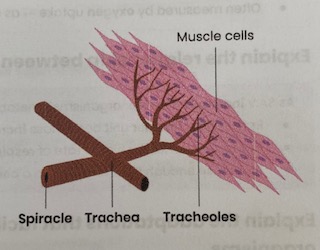
Explain structural and functional compromises in terrestrial insects that allow efficient gas exchange while limiting water loss
Thick waxy cuticle/ exoskeleton= increases diffusion distance so less water loss (evaporation)
Spiracles can open to allow gas exchange AND close to reduce water loss (evaporation)
Hairs around spiracles= trap moist air, reducing water potential gradient so less water loss (evaporation)
Explain how the gills of fish are adapted for gas exchange
Gills made of many filaments covered with many lamellae
increases SA for diffusion
Thin lamellae wall/ epithelium
so short diffusion distance between water/ blood
Lamellae have a large number of capillaries
remove O2 and bring CO2 quickly so maintains conc gradient
Counter current flow
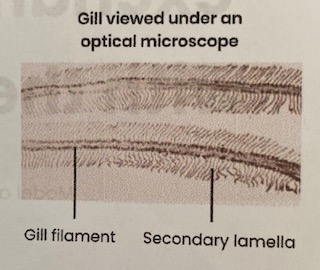
What is counter current flow?
Blood and water flow in opposite directions through/ over lamellae
So oxygen conc always higher in water (than blood)
So maintains a conc gradient of O2 between water and blood
For diffusion along whole length of lamellae
If parallel flow, equilibrium would be reached so oxygen wouldn’t diffuse into blood along the whole gill plate.
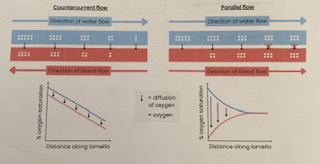
Explain how the leaves of dicotyledonous plants are adapted for gas exchange
Many stomata (high density)= large SA for gas exchange (when opened by guard cells)
Spongy mesophyll contains air spaces= large SA for gases to diffuses through
Thin= short diffusion distance
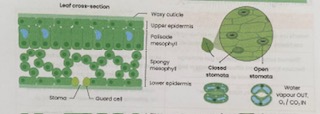
What is a xerophyte?
plant adapted to live in very dry conditions e.g. cacti and marram grass
Explain structural and functional compromises in xerophytic plants that allow efficient gas exchange while limiting water loss
Thicker waxy cuticles
increases diffusion distance so less evaporation
Sunken stomata in pits/ rolled leaves/ hairs
‘trap’ water vapour/ protect stomata from wind
so reduced water potential gradient between leaf/ air
so less evaporation
Spines/ needles
reduces SA:V
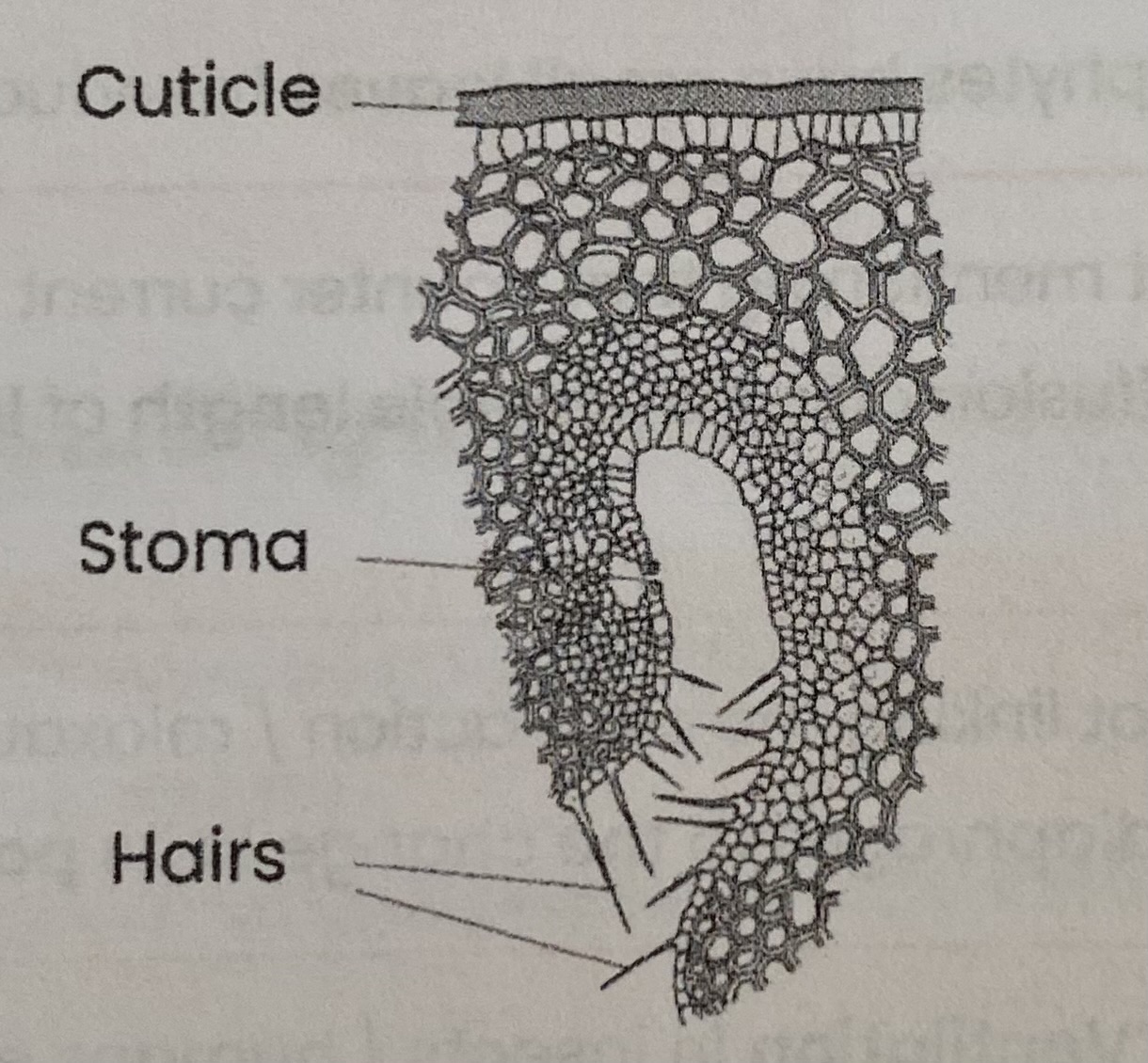
Describe the gross structure of the human gas exchange system
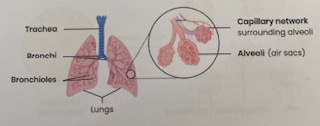
Explain the essential features of the alveolar epithelium that make it adapted as a surface for gas exchange
Flattened cells/ 1 cell thick= short diffusion distance
Folded= large SA
Permeable= allows diffusion of O2/CO2
Moist= gases can dissolve for diffusion
Good blood supply from large network of capillaries= maintains conc gradient
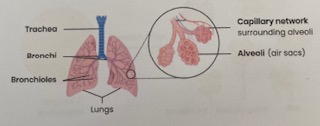
Describe how gas exchange occurs in the lungs
Oxygen diffuses from alveolar air space into blood down its conc gradient
across alveolar epithelium then across capillary endothelium
CO2= opposite
Explain the importance of ventilation
Brings in air containing higher conc of O2 and removes air with lower conc of oxygen
maintaining conc gradient
Explain how humans breathe in and out (ventilation)
INSPIRATION (breathing in)
Diaphragm muscles contract= flattens
External intercostal muscles contract, internal intercostal muscles relax (antagonistic)= ribcage pulled up/ out
Increasing volumeand decreasing pressure (below atmospheric) in thoracic cavity
Air moves into lungs down pressure gradient
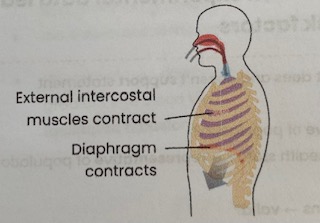
Explain how humans breathe in and out (ventilation)
EXPIRATION (breathing out)
Diaphragm relaxes= moves upwards
External intercostal muscles relax, internal intercostal muscles may contract= ribcage moves down/ in
Decreasing volume and increasing pressure (above atmospheric) in thoracic cavity
Air moves out of lungs down pressure gradient
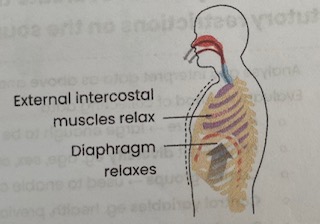
Suggest why expiration is normally passive at rest
Internal intercostal muscles do not normally need to contract
Expiration aided by elastic recoil in alveoli
Suggest how different lung diseases reduce the rate of gas exchange
Thickened alveolar tissue (e.g. fibrosis)= increases diffusion distance
Alveolar wall breakdown= reduces SA
Reduce lung elasticity= lungs expand/ recoil less= reduces conc gradients of O2 and CO2
Suggest how different lung diseases affect ventilation
Reduce lung elasticity (e.g. fibrosis= build up of scar tissue)= lungs expand/ recoil less
reducing volume of air in each breath(tidal volume)
reducing maximum volume of air breathed out in one breath (forced vital capacity)
Narrow airways/ reduce airflow in and out of lungs (e.g. asthma- inflamed bronchi)
reducing maximum volume of air breathed out in 1 second (forced expiratory volume)
Reduced rate of gas exchange= increased ventilation rate to compensate for reduced oxygen in blood
Suggest why people with lung disease experience fatigue
cells receive less oxygen= rate of aerobic respiration reduced= less ATP made
Suggest how you can analyse and interpret data to the effects of pollution, smoking and other risk factors on the incidence of lung disease
Describe overall trend= e.g. positive/ negative correlation between risk factor and incidence of disease
Manipulate data= e.g. calculate percentage change
Interpret standard deviations= overlap suggests differences in means are likely to be due to chance
Use statistical tests= identify whether difference/ correlation is significant or due to chance
correlation coefficient= examining on association between 2 sets of data
student’s t test= comparing means of 2 sets of data
chi-squared test= for categorical data
Suggest how you can evaluate the way in which experimental data led to statutory restrictions on the sources of risk factors
Analyse and interpret data as above and identify what does and doesn’t support statement
Evaluate method of collecting data
sample size= large enough to be representative of population?
participant diversity e.g. age, sex, ethnicity and health status= representative of population?
control groups= used to enable comparison?
control variables e.g. health, previous medications= valid?
duration of study= long enough to show long-term effects?
Evaluate context= has a broad generalisation been made from a specific set of data?
Other risk factors that could have affected results?
Explain the difference between correlations and causal relationships
correlation= change in one variable reflected by a change in another- identified on a scatter graph
causation= change in one variable causes a change in another variable
correlation does not mean causation= may be other factors involved
Explain what happens in digestion
Large (insoluble) biological molecules hydrolysed to smaller (soluble) molecules
That are small enough to be absorbed across cell membranes into blood
Describe the digestion of starch in mammals
Amylase (produced by salivary glands/ pancreas) hydrolyses starch to maltose
Membrane- bound maltase (attached to cells lining ileum) hydrolyses maltose to glucose
Hydrolysis of glycosidic bond

Describe the digestion of disaccharides in mammals
Membrane-bound disaccharides hydrolyse disaccharides to 2 monosaccharides:
Maltase= maltose= glucose + glucose
Sucrase= sucrose= fructose + glucose
Lactase= lactose= galactose + glucose
Hydrolysis of glycosidic bond
Describe the digestion of lipids in mammals, including action of bile salts
Bile salts (produced by liver) emulsify lipids causing them to form smaller lipid droplets
This increases SA of lipids for increased/ faster lipase activity
Lipase (made in pancreas) hydrolyses lipids (e.g. triglycerides) = monoglycerides + fatty acids
Hydrolysis of ester bond
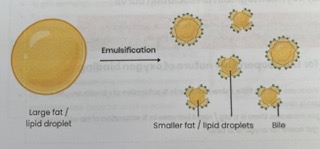
Describe the digestion of proteins by a mammal
Endopeptidases= hydrolyse internal (peptide) bonds within a polypeptide= smaller peptides
so more ends/ SA for exopeptidases
Exopeptidases= hydrolyse terminal (peptide) bonds at ends of polypeptide= single amino acids
Membrane- bound dipeptidases= hydrolyse (peptide) bond between a dipeptide= 2 amino acids
Hydrolysis of peptide bond

Suggest why membrane- bound enzymes are important in digestion
Membrane-bound enzymes are located on cell membranes of epithelial cells lining ileum
(By hydrolysing molecules at the site of absorption they) maintain conc gradients for absorption
Describe the pathway for absorption of products of digestion in mammals
Lumen (inside) of ileum= cells lining ileum (part of small intestine)= blood
Describe the absorption of amino acids and monosaccharides in mammals
CO-TRANSPORT:
Na+ actively transported from epithelial cells lining ileum to blood (by Na+/ K+ pump), establishing a conc gradient of Na+ (higher in lumen than epithelial cell)
Na+ enters epithelial cell down its conc gradient with glucose against its conc gradient via a co-transport protein
Glucose moves down a conc gradient into blood via facilitated diffusion
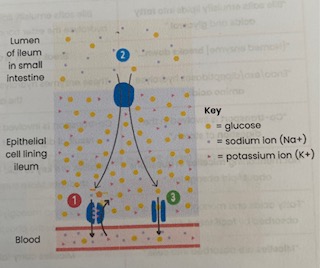
Describe the absorption of lipids by a mammal, including the role of micelles
Micelles contain bile salts, monoglycerides and fatty acids
make monoglycerides and fatty acids (more) soluble in water
carry/ release fatty acids and monoglycerides to cell/ lining of ileum
maintain high conc of fatty acids to cell/ lining
Monoglycerides/ fatty acids absorbed (into epithelial cell) by diffusion (lipid soluble)
Triglycerides reformed in (epithelial) cells and aggregate into globules
Globules coated with proteins forming chylomicrons which are then packaged into vesicles
Vesicles move to cell membrane and leave via exocytosis
enter lymphatic vessels and eventually return to blood circulation